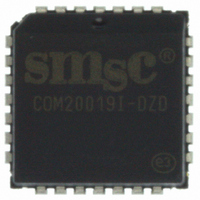COM20019I-DZD SMSC, COM20019I-DZD Datasheet - Page 38

COM20019I-DZD
Manufacturer Part Number
COM20019I-DZD
Description
IC CTRLR ARCNET 2KX8 RAM 28-PLCC
Manufacturer
SMSC
Series
ARCNETr
Datasheet
1.COM20019I-DZD.pdf
(65 pages)
Specifications of COM20019I-DZD
Controller Type
ARCNET Controller
Interface
Differential
Voltage - Supply
4.5 V ~ 5.5 V
Current - Supply
20mA
Operating Temperature
0°C ~ 70°C
Mounting Type
Surface Mount
Package / Case
28-PLCC
Lead Free Status / RoHS Status
Lead free / RoHS Compliant
Other names
638-1000-5
Available stocks
Company
Part Number
Manufacturer
Quantity
Price
Company:
Part Number:
COM20019I-DZD
Manufacturer:
SMSC
Quantity:
1 028
Company:
Part Number:
COM20019I-DZD
Manufacturer:
Microchip Technology
Quantity:
10 000
Company:
Part Number:
COM20019I-DZD-TR
Manufacturer:
Microchip Technology
Quantity:
10 000
6.4.3
Rev. 09-25-07
lengths must be sent, the user must add dummy bytes to the packet in order to make the packet fit into a
long packet.
Once the packet is written into the buffer, the microcontroller awaits a logic "1" on the TA bit, indicating that a
previous transmit command has concluded and another may be issued. Each time the message is loaded
and a transmit command issued, it will take a variable amount of time before the message is transmitted,
depending on the traffic on the network and the location of the token at the time the transmit command was
issued. The conclusion of the Transmit Command will generate an interrupt if the Interrupt Mask allows it. If
the device is configured for the Command Chaining operation, please see the Command Chaining section for
further detail on the transmit sequence. Once the TA bit becomes a logic "1", the microcontroller may issue
the "Enable Transmit from Page fnn" command, which resets the TA and TMA bits to logic "0". If the
message is not a BROADCAST, the COM20019I automatically sends a FREE BUFFER ENQUIRY to the
destination node in order to send the message. At this point, one of four possibilities may occur.
The first possibility is if a free buffer is available at the destination node, in which case it responds with an
ACKnowledgement. At this point, the COM20019I fetches the data from the Transmit Buffer and performs the
transmit sequence. If a successful transmit sequence is completed, the TMA bit and the TA bit are set to
logic "1". If the packet was not transmitted successfully, TMA will not be set. A successful transmission
occurs when the receiving node responds to the packet with an ACK. An unsuccessful transmission occurs
when the receiving node does not respond to the packet.
The second possibility is if the destination node responds to the Free Buffer Enquiry with a Negative
AcKnowledgement. A NAK occurs when the RI bit of the destination node is a logic "1". In this case, the
token is passed on from the transmitting node to the next node. The next time the transmitter receives the
token, it will again transmit a FREE BUFFER ENQUIRY. If a NAK is again received, the token is again
passed onto the next node. The Excessive NAK bit of the Diagnostic Status Register is used to prevent an
endless sending of FBE's and NAK's. If no limit of FBE-NAK sequences existed, the transmitting node would
continue issuing a Free Buffer Enquiry, even though it would continuously receive a NAK as a response. The
EXCNAK bit generates an interrupt (if enabled) in order to tell the microcontroller to disable the transmitter via
the "Disable Transmitter" command. This causes the transmission to be abandoned and the TA bit to be set
to a logic "1" when the node next receives the token, while the TMA bit remains at a logic "0". Please refer to
the Improved Diagnostics section for further detail on the EXCNAK bit.
The third possibility which may occur after a FREE BUFFER ENQUIRY is issued is if the destination node
does not respond at all. In this case, the TA bit is set to a logic "1", while the TMA bit remains at a logic "0".
The user should determine whether the node should try to reissue the transmit command.
The fourth possibility is if a non-traditional response is received (some pattern other than ACK or NAK, such
as noise). In this case, the token is not passed onto the next node, which causes the Lost Token Timer of the
next node to time out, thus generating a network reconfiguration.
The "Disable Transmitter" command may be used to cancel any pending transmit command when the
COM20019I next receives the token. Normally, in an active network, this command will set the TA status bit
to a logic "1" when the token is received. If the "Disable Transmitter" command does not cause the TA bit to
be set in the time it takes the token to make a round trip through the network, one of three situations exists.
Either the node is disconnected from the network, or there are no other nodes on the network, or the external
receive circuitry has failed. These situations can be determined by either using the improved diagnostic
features of the COM20019I or using another software timeout which is greater than the worst case time for a
round trip token pass, which occurs when all nodes transmit a maximum length message.
Receive Sequence
A receive sequence begins with the RI status bit becoming a logic "1", which indicates that a previous
reception has concluded. The microcontroller will be interrupted if the corresponding bit in the Interrupt
Mask Register is set to logic "1". Otherwise, the microcontroller must periodically check the Status
Register. Once the microcontroller is alerted to the fact that the previous reception has concluded, it may
issue the "Enable Receive to Page fnn" command, which resets the RI bit to logic "0" and selects a new
page in the RAM buffer. Again, the appropriate buffer size is specified in the "Define Configuration"
DATASHEET
Page 38
Cost Competitive ARCNET (ANSI 878.1) Controller with 2K x 8 On-Chip RAM
SMSC COM20019I













